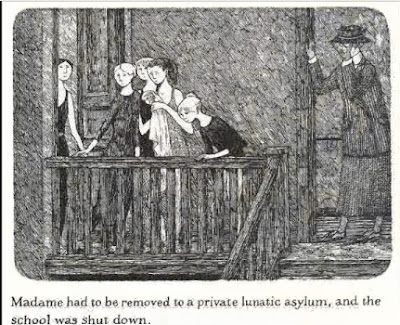Hi everyone! Long time no see! Grad school does that to you, man.
Anyway,
Io9, brilliant blog that it is, directed our attention to the fairy tale illustrations of Edward Gorey. The thing that I love most about Edward Gorey is his ability to depict something horrific without actually showing it to you. He shows you the before, or the after, or what is happening off screen, not the actual event itself.
Exhibit A:
From The Gilded Bat by Edward Gorey
In the book, Three Classic Children's Stories, Edward Gorey doesn't go quite as far as that, but he still has an fascinating way of choosing moments and framing. Of course you have the classing Little Red Riding Hood meeting the wolf picture:
But then you also have this:
All you can see are the wolf's toes and Little Red Riding Hood's eyes. Somehow it is a little worse than your typical Wolf in Grandma's Clothing picture. It is a "just before" moment. You imagination conjures up the big eyes and the big teeth, and then the next scene where he eats her.
For the Jack and the Beanstalk story, we have this picture:
It takes place either right before, or (a bit more disturbingly) right after Jack hits the trapped giant in the head with the shovel and kills him. Jack looks so jovial, and the giant looks so sad. It is a bit heart breaking.
The Rumpelstiltskin images are what you would expect, until you get to this one:
This is after the queen has guessed Rumpelstiltskin's name, and he gets so angry that he stomps a hole in the floor and tears himself in two. The cloth disappearing down the hole is his sleeve, so it seems he just got swallowed up, but the peace on the queen's face and the oblivious king flavor the picture really well.
There are lots more pictures over at
Brainpickings if you want to check them out!
